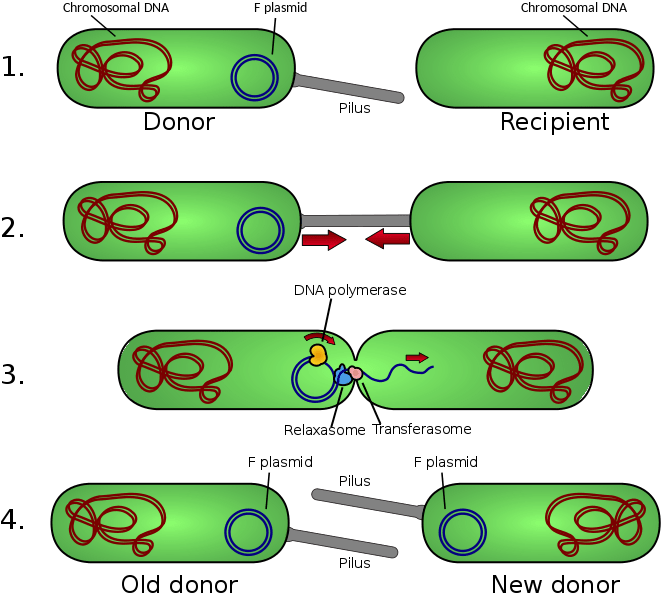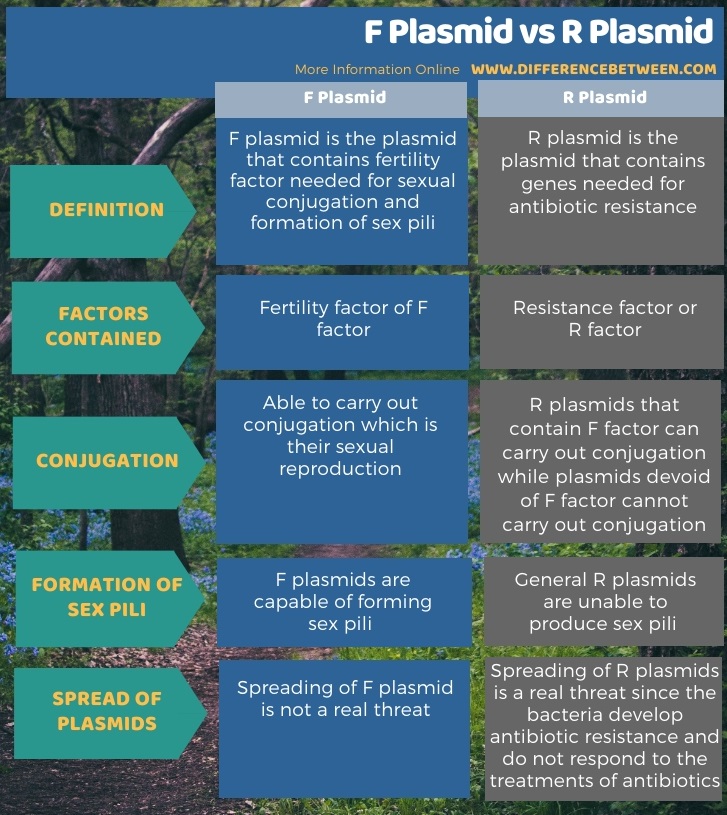Difference Between F Plasmid and R Plasmid
Table of Contents
The key difference between F plasmid and R plasmid is that F plasmid is an extrachromosomal DNA that contains genes coding for fertility factor. Meanwhile, R plasmid is an extrachromosomal DNA that contains genes coding for the resistance against antibiotics.
A plasmid is a small circular double-stranded DNA present in bacteria. They are extrachromosomal DNA and is capable of self-replication. They carry genes necessary for their self replication and maintenance. Besides containing the genes that are necessary for self-replication, plasmids also contain several other necessary genes for coding special traits, such as antibiotic resistance, degradation of macromolecules, heavy metal tolerance, production of bacteriocins, transfer of genes, etc., which are beneficial to bacteria.
Moreover, there is a great variety of plasmids. R plasmids and F plasmids are two types among them. F plasmid is a fertility plasmid that is capable of conjugation and production of sex pili. R plasmid is a resistance plasmid that is capable of providing resistance against antibiotics and certain bacterial growth inhibitors.
CONTENTS
1. Overview and Key Difference
2. What is F Plasmid
3. What is R Plasmid
4. Similarities Between F Plasmid and R Plasmid
5. Side by Side Comparison – F Plasmid vs R Plasmid in Tabular Form
6. Summary
What is F Plasmid?
Some bacterial strains possess F plasmids in addition to their chromosomes. These strains are known as F+ strains. They act as donor cells or males in bacterial conjugation, a sexual reproduction mechanism shown by bacteria which facilitates horizontal gene transferring between bacteria. F plasmids can replicate independently and contain fertility factor coding genes called tra genes. Hence, these extrachromosomal DNA (plasmids) are named as F plasmids due to the F factor or fertility factor. Fertility factor coding genes are essential for transfer or conjugation.
Bacterial strains which receive F plasmids from F+ strains are known as F- strains or recipient strains or females. F+ strains can donate their genetic material or extrachromosomal DNA to another bacterium.

Figure 01: F Plasmid and Conjugation
Bacterial conjugation starts with the production of sex pili by F+ strains to contact with F- bacterium. Sex pilus facilitates the cell to cell communication and contact by forming a conjugation tube. This formation is governed by the fertility factor genes borne by F+ strain. F+ replicates its F plasmid and makes a copy of it to transfer into F- strain. The copied F plasmid transfers to the F- strain via conjugation tube. Once it transfers, conjugation tube dissociates. The recipient strain becomes F+. During bacterial conjugation, only the F plasmid is transferred from F+ strain to F- strain without transferring the bacterial chromosome.
What is R Plasmid?
R plasmid or resistance plasmid is an extra-chromosomal DNA of bacteria that contains genes code for antibiotic resistance. Therefore, R plasmids containing bacteria show resistance against antibiotics. R plasmids were demonstrated in the bacterium Shigella first by Japanese scientists. R plasmids were known as R factors before the nature of plasmids was understood. Generally, R plasmids contain several antibiotic-resistant genes. In other words, single R factor codes for more than one antibiotic-resistant gene, sometimes up to 8 different antibiotics.

Figure 02: R Plasmid
The antibiotic resistance or R plasmids can pass from one bacterium to another and spread through genera and families. It occurs in F plasmids via bacterial conjugation; a means of sexual reproduction seen in bacteria. During bacterial conjugation, R factor-containing F plasmid contact with another bacterium and horizontally transfers R factor between two bacteria through the sex pilus. And, this is the most common way of spread and development of antibiotic resistance in bacteria.
What are the Similarities Between F Plasmid and R Plasmid?
- F plasmid and R plasmid are two types of plasmids.
- Bacteria are the microorganisms containing these plasmids.
- Many plasmids carry both the F factor and R factor together.
- They are extrachromosomal DNA.
- Both types are closed circular DNA molecules.
- They consist of double-stranded DNA.
- Moreover, they contain genes that provide additional beneficial characteristics to bacteria.
- These plasmids can self replicate.
- Moreover, they can pass from one bacterium to another and involve in horizontal gene transfer.
What is the Difference Between F Plasmid and R Plasmid?
F plasmid is the plasmid that contains the fertility factor needed for sexual conjugation and formation of sex pili. Meanwhile, R plasmid is the plasmid that contains genes needed for antibiotic resistance. So, this is the key difference between F plasmid and R plasmid. Moreover, F plasmids are capable of forming sex pili. On the other hand, general R plasmids are unable to produce sex pili. Therefore, this is another difference between F plasmid and R plasmid.
Furthermore, an important difference between F plasmid and R plasmid is the threat they cause. That is; the spread of F plasmid does not pose a real threat unless it contains R factor, while the spread of R plasmid is a real threat since it aids in developing resistance against antibiotics in bacterial populations.

Summary – F Plasmid vs R Plasmid
F plasmid is a plasmid that carries the fertility factor that allows the transfer of genetic material from one bacterium to another through conjugation. Moreover, F plasmids are episomes that can integrate its DNA into the chromosome of another bacterium. Whereas, R plasmid is a plasmid that carries a resistance factor which confers resistance to antibiotics or other bacterial growth inhibitors. Many plasmids contain both the F factor and R factor. The spread of R plasmids is a real threat than spreading of F plasmids since bacteria gain resistance against antibiotic treatments. So, this summarizes the difference between F plasmid and R plasmid.
Reference:
1. “R-Factor.” Wikipedia, Wikimedia Foundation, 28 Sept. 2019, Available here.
2. “Bacterial Plasmids: Definition, Function & Uses.” Study.com, Study.com, Available here.
Image Courtesy:
1. “Conjugation” By Adenosine – Own work (CC BY-SA 3.0) via Commons Wikimedia
2. “PBR322” By Ayacop (+ Yikrazuul) – Own work (Public Domain) via Commons Wikimedia
ncG1vNJzZmivp6x7pbXFn5yrnZ6YsqOx07CcnqZemLyue8OinZ%2Bdopq7pLGMm5ytr5Wau26yjKmjmqudnrFurc2dZKtloKGutLnInWY%3D